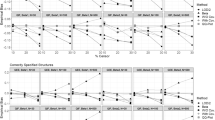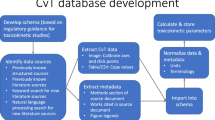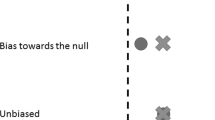Abstract
Biomarker measurements from single time points are often used to make inferences about longer periods of toxicant intake. However, toxicant exposures rarely, if ever, occur under steady-state conditions, and biomarkers are typically most sensitive to recent toxicant exposures. Moreover, toxicant exposures are typically episodic and vary in magnitude over time. While it is often believed that the error introduced by the steady-state assumption is minimal and can safely be ignored, no rationale is typically presented to support this belief. Moreover, no guidelines have been established for determining a de minimus error level or for estimating the degree of error potentially introduced by a fallacious steady-state assumption in biomarker interpretation. We present a statistical framework for evaluating the potential magnitude of the error introduced by the steady-state fallacy and demonstrate applications of the framework to blood mercury and hair mercury exposure biomarkers in human adults. The magnitude of error clearly depends on many factors, including the exposure frequency, exposure magnitude, exposure duration, and exposure inference duration. Graphical presentation of the error as a function of those factors provides insight into the interpretation of mercury exposure biomarkers. We describe a general approach for determining the mean and variance of temporal error, present explicit solutions for several special cases, and demonstrate an example using the framework to evaluate the error resulting from the use of a steady-state model to estimate time-varying exposure from mercury biomarkers.
This is a preview of subscription content, access via your institution
Access options
Subscribe to this journal
Receive 6 print issues and online access
$259.00 per year
only $43.17 per issue
Buy this article
- Purchase on Springer Link
- Instant access to full article PDF
Prices may be subject to local taxes which are calculated during checkout




Similar content being viewed by others
References
Agency for Toxic Substances and Disease Registry. Toxicological profile for lead, ATSDR/T-92/12. US Department of Health and Human Services, Altanta, GA, 1993.
Bartell S.M., Ponce R.A., Sanga R.N., and Faustman E.M . Human variability in mercury toxicokinetics and steady state biomarker ratios. Environ Res 2000: 84: 127–132.
Buck R.J., Hammerstrom K.A., and Ryan P.B . Estimating long-term exposures from short-term measurements. J Expo Anal Environ Epidemiol 1995: 5(3): 359–373.
Carrington C.D., Cramer G.M., and Bolger P.M . A risk assessment for methylmercury in tuna. Water Air Soil Pollut 1997: 97: 273–283.
Clewell H.J., Gearhart J.M., Gentry P.R., Covington T.R., VanLandingham C.B., Crump K.S., and Shipp A.M . Evaluation of the uncertainty in an oral reference dose for methylmercury due to interindividual variability in pharmacokinetics. Risk Anal 1999: 19(4): 547–558.
Environmental Protection Agency (EPA). Risk assessment guidance for superfund, Volume 1: human health evaluation manual (Part A), EPA/540/1-89/002. Office of Emergency and Remedial Response, Washington, DC, 1990.
EPA. Guidance manual for the integrated exposure uptake biokinetic model for lead in children, EPA/540/R-93/081. Office of Solid Waste and Emergency Response, Washington, DC, 1994.
EPA. Urban Soil Lead Abatement Demonstration Project, Volume 1: Integrated Report, EPA/600/P-93/001aF. National Center for Environmental Assessment, Office of Research and Development, Research Triangle Park, NC, 1996.
EPA. Integrated Risk Information System: mercury; 2001. URL: http://www.epa.gov/iris/subst/0073.htm
DeGroot M.H . Probability and Statistics, 2nd Edn. Addison-Wesley Publishing Company, Reading, MA, 1989.
Gray D.G . A physiologically-based pharmacokinetic model for methylmercury in the pregnant rat and fetus. Toxicol Appl Pharmacol 1995: 132: 91–102.
Lipfert F.W., Moskowitz P.D., Fthenakis V., and Saroff L . Probabilistic assessment of health risks of methylmercury from burning coal. Neurotoxicology 1996: 17(1): 197–212.
Ponce R.A., Bartell S.M., Kavanagh T.J., Woods J.S., Griffith W.C., Lee R.C., Takaro T.K., and Faustman E.M . Uncertainty analysis methods for comparing predictive models and biomarkers: a case study of dietary methyl mercury exposure. Regul Toxicol Pharmacol 1998: 28(2): 96–105.
Rhomberg L . Framing the aggregate exposure questions. Presentation at the Annual Meeting of the Society for Risk Analysis, Atlanta, GA, 1999.
Sherlock J., Hislop J., Newton D., Topping G., and Whittle K . Elevation of mercury in human blood from controlled chronic ingestion of methylmercury in fish. Human Toxicol 1984: 3: 117–131.
Sherlock J.C., and Quinn M.J . Underestimation of dose–response relationship with particular reference to the relationship between the dietary intake of mercury and its concentration in blood. Hum Toxicol 1988: 7: 129–132.
Stern A.H . Estimation of interindividual variability in the one-compartment pharmacokinetic model for methylmercury: implications for the derivation of the reference dose. Regul Toxicol Pharmacol 1997: 25: 277–288.
Slob W . Modeling long-term exposure of the whole population to chemicals in food. Risk Anal 1993: 13(5): 525–530.
Wallace L.A., Duan N., and Ziegenfus R . Can long-term exposure distributions be predicted from short-term measurements? Risk Anal 1994: 14(1): 75–85.
Wong E.Y., Shirai J.H., Garlock T.J., and Kissel J.C . Adult proxy responses to a survey of children's dermal soil contact activities. J Expo Anal Environ Epidemiol 2000: 10(6 Part 1): 509–517.
World Health Organization. Environmental Health Criteria 101: Methylmercury. World Health Organization, Geneva, 1990.
Acknowledgements
Thanks to Dr. Rafael Ponce, Dr. Robert Shumway, Dr. Kevin Brand, and three anonymous reviewers for their valuable suggestions. This research was supported by the University of Washington National Research Center for Statistics and the Environment through US Environmental Protection Agency cooperative agreement CR825173, by the University of California, Davis, Center for Environmental Health Sciences through the National Institute of Environmental Health Sciences, and by the US Environmental Protection Agency Science to Achieve Results Graduate Student Fellowship program. This paper does not necessarily reflect the views of the supporting agencies and no official endorsement should be inferred.
Author information
Authors and Affiliations
Corresponding author
Rights and permissions
About this article
Cite this article
Bartell, S., Griffith, W. & Faustman, E. Temporal error in biomarker-based mean exposure estimates for individuals. J Expo Sci Environ Epidemiol 14, 173–179 (2004). https://doi.org/10.1038/sj.jea.7500311
Received:
Accepted:
Published:
Issue Date:
DOI: https://doi.org/10.1038/sj.jea.7500311
Keywords
This article is cited by
-
Prenatal mercury exposure, autism, and developmental delay, using pharmacokinetic combination of newborn blood concentrations and questionnaire data: a case control study
Environmental Health (2015)
-
Single blood-Hg samples can result in exposure misclassification: temporal monitoring within the Japanese community (United States)
Environmental Health (2012)
-
Chronologically matched toenail-Hg to hair-Hg ratio: temporal analysis within the Japanese community (U.S.)
Environmental Health (2012)
-
Estimating equations for biomarker based exposure estimation under non-steady-state conditions
Environmental Health (2011)



